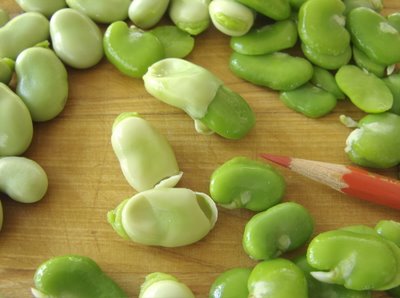 If Jack from the tale “Jack and the Bean Stalk” had not traded the family cow for a few beans his life would have remained impoverished. No sack of gold, no hen to lay the golden eggs, no gold singing harp and finally no marriage to a great princess. Beans provide for some nice perks and that is what I hope to convince you of. For me the “Queen Bean” is the Fava, so much so when I see fresh Favas I get excited enough to make proclamations to the produce staff at our local Publix market. I admit to having said “These beans are like eating poetry”, “Favas make a dish fit for kings and beggars alike”, “ A mouthful will stop time.” With wide eyes and speechless lips they eye the unfamiliar bean not knowing what to say in reply. I load my cart with the large green lumpy pods, priced at $1.99 a pound and feel as if I have just won the lottery. So if you want to live happily ever after read on.
If Jack from the tale “Jack and the Bean Stalk” had not traded the family cow for a few beans his life would have remained impoverished. No sack of gold, no hen to lay the golden eggs, no gold singing harp and finally no marriage to a great princess. Beans provide for some nice perks and that is what I hope to convince you of. For me the “Queen Bean” is the Fava, so much so when I see fresh Favas I get excited enough to make proclamations to the produce staff at our local Publix market. I admit to having said “These beans are like eating poetry”, “Favas make a dish fit for kings and beggars alike”, “ A mouthful will stop time.” With wide eyes and speechless lips they eye the unfamiliar bean not knowing what to say in reply. I load my cart with the large green lumpy pods, priced at $1.99 a pound and feel as if I have just won the lottery. So if you want to live happily ever after read on.Some Basic Facts;
Fava beans have been on the menu for 9000 years, first appearing during Neolithic times in the Middle East. Fava beans are well travelled and now appear world wide except in the lowland tropics. It is important to note that a small minority of people in certain populations (usually of Mediterranean extraction) have a negative reaction to favas known as “favism”, on the other side of the coin favas are being studied as a way to control the symptoms of “ Parkinson's Disease”. There is much information to be found on the internet, the “Long History of the Mysterious Fava Bean”is a good place to start. Some years ago I purchased “A Gardeners Guide To Fava Beans” by Ianto Evans. A little pamphlet publication published by a group know as the “Fava bean project” is a good reference. It includes some recipes and information on how to grow favas. It may be helpful if you can find it, I have not been able to locate a source.
Initial Preparation;
Fava beans come both fresh and dried and the month of June is the time to find the fresh ones. The season for fresh favas is early spring to early summer, I most recently had them on the Fourth of July. Preparation for fresh favas is a two step process. Like English Peas they need to be shelled, if you are not dealing with a bushel this is relaxing to do. Once out of the pod the beans should be blanched in boiling water for one minute to loosen the skin around the bean, then drained and cooled in an ice bath. The outer husk can be removed by pinching the edible bean out of the husk, for me this involves making a small cut with my thumb nail then squeezing out the bean using thumb and fore finger. The beans are so beautiful the process becomes zen meditation, something to be enjoyed.
 Pinching and squeezing the bean.
Pinching and squeezing the bean.Fresh Favas Sautéed in Olive Oil with Garlic
Not much to explain here. Use a good oil with flavor, fruity or spicy, a clove of garlic, more for garlic lovers. Slowly sauté the beans for 10 to 15 minutes stirring often. Season with salt to taste and add a squeeze of lemon juice if desired. For a slightly different flavor add either a small quaintly of minced pancetta or prosciutto along with the garlic and olive oil.
Favas with Pasta
The recipe comes with some adaptation from the pages
of “The magazine of La Cucina Italiana” May-June 2006.
The magazine gives directions for making a hand made fresh pasta called “Trofie” little twists of pasta. If making your own pasta is something you have time for it will improve the texture and flavor of this dish. My personal preference for this dish is to keep the pasta delicate, whether fresh or dried. We used a pasta made by the Alessi company, called “Casarecci.”
Start your pasta water, once boiling add salt and dried pasta. In a skillet (large enough to accommodate the pasta) melt the butter add the garlic and sauté until golden, add the favas and the pine nuts and sauté for 3 to 5 minutes. (if using fresh pasta cook after sauce is made) Drain pasta add to the skillet with the mache, cook until the lettuce is wilted about 1 minute.
 *Cooks note; I like to add additional butter along with a tablespoon or two of pasta water making the sauce looser and richer. Season with salt and pepper, toss well, pass Parmigiano-Reggiano at the table.
*Cooks note; I like to add additional butter along with a tablespoon or two of pasta water making the sauce looser and richer. Season with salt and pepper, toss well, pass Parmigiano-Reggiano at the table.Risotto with Fava Beans and Fennel
Risotto con fave e finocchio
Recipe adapted from “A Fresh Taste of Italy” by Michele Scicolone. *I highly recommend this book, with more than 250 recipes it covers the basics to specialities, clearly written and accessible to any one who has just a spark of interest in Italian cuisine.
Shell the fava beans then peel off the thin skin that covers each bean. You should have about 1 1/2 cups.
Trim off the dark green feathery leaves and stalks of the fennel down to the rounded bulb. Cut a slice off the stem end with a vegetable peeler, trim away any brown spots or bruises. Cut the fennel length wise into quarters, then crosswise into thin slices.
In a large heavy saucepan melt 1 tablespoon of the butter with the olive oil over medium -low heat. Add the green onions and cook until tender, about 3 minutes. Add the fennel and cook for 10 minutes, stirring occasionally.
Raise the heat to medium high. Add the rice and cook stirring constantly for 1 to 2 minutes, until coated and shiny. Add about 1/2 cup of the broth. Cook, stirring constantly, until most of the liquid is absorbed. The spoon should leave a wide track on the bottom of the pan yet there should be liquid surrounding each grain.
Continue adding the broth about 1/2 cup at a time, stirring after each addition. Adjust the heat, if necessary, so that the liquid simmers rapidly, but the rice does not stick to the bottom of the pan.
After 15 minutes, stir in the fava beans. Add salt and pepper. Continue adding broth 1/2 cup at a time and stirring until the rice is tender yet firm to the bite and a creamy sauce forms around the rice and vegetables. Use only as much of the liquid as necessary. If you run out of broth, switch to hot water. Remove from heat.
Vigourously stir in the remaining butter and cheese. Serve immediately.
*Cooks note: I always add some of the broth at the very end if necessary to give the creamy consistency if the rice is too sticky.
In the “Chez Panisse Vegetables” cookbook by Alice Waters, we found a nice selection of fava bean recipes including a purée, a soup and a dish with artichokes all are worth exploring.
Related Tags: fresh fava beans, chez panisse vegetables, risotto with fava beans and fennel, favas with pasta







1 comment:
Oooo I couldn't agree with you more about these beans! As I scrolled down the pasta recipe I was ooohing and aahing at each ingredient, and then the luscious picture! Heavenly! I will try this recipe soon. I want to figure out how to grow my own too. Thanks for posting the proper homage this bean is due!
Post a Comment